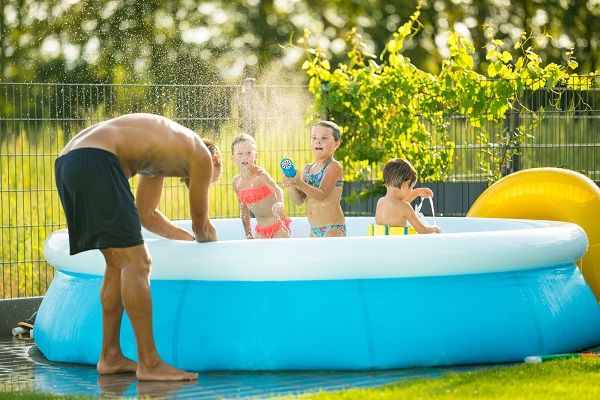 Summer is heating up and some families are turning to their own backyards to stay cool by purchasing temporary above-ground pools. These types of pools have specific drowning and safety concerns that families should be aware of.
Summer is heating up and some families are turning to their own backyards to stay cool by purchasing temporary above-ground pools. These types of pools have specific drowning and safety concerns that families should be aware of.
Dangers of backyard pools
Backyard pools in general pose the greatest threat to children ages 1 through 4, who are unlikely to have had swim lessons and unaware of the dangers of water. Backyard pools tend to be placed close to a house, so it is easy for young children to get out of the house and into the water without anybody noticing.
“Kids have drowned when parents didn’t mean for them to be in the pool,” said Isabell Sakamoto, Suicide and Injury Prevention Program Manager at Seattle Children’s. “With that in mind, having a pool set up in the backyard requires a different level of attention than planning a day at the lake or ocean.”
Backyard pool safety
Above-ground pools in backyards are uniquely dangerous because they are usually meant to be temporary. Due to their temporary nature, it’s easy to overlook safety precautions, such as fencing, rescue equipment and door alarms. This makes it easier for children to quickly sneak outside and into the pool or accidentally fall in the pool without a parent or caregiver’s knowledge.
To help keep kids safe, use the same safety precautions for in-ground pools and above-ground pools.
- Install fencing around the entire pool that is at least 4-feet high and has a self-closing gate.
- Keep rescue equipment, such as a throw ring, where it’s easy to see and reach quickly.
- Remove water toys from the pool when not in use so young children are not tempted to go in.
- Consider purchasing alarms for the pool itself or for doors leading outside. These alarms will alert parents and caregivers when somebody is in or near the pool.
- Provide life jackets to young children and non-swimmers. Water wings are not a safe alternative to life jackets.
- Always have an adult water watcher when children are swimming.
Additional safety precautions to take specific to above-ground pools:
- Make sure children and parents are aware of the depth of the water before using.
- Kiddie pools and smaller pools, which are typically unfiltered and unchlorinated, are more likely to collect germs, so empty and clean them after each use.
- Completely drain kiddie pools when not in use and larger above-ground pools at the end of the season.
It is especially important to drain kiddie pools after every use, as young kids can easily climb into them when there is no adult supervision.
“It can be tempting to keep your kiddie pool filled as a way to save time and conserve water, but it’s just not worth the risk,” Sakamoto said. “Children can drown in less than two inches of water and it can happen fast, before you notice they’re missing. Make it a habit to drain temporary pools when they aren’t being used, and assign a water watcher for every swim.”
Have a water watcher
The National Drowning Prevention Alliance notes that nationwide, 23% of drownings happen near a pool during friend and family gatherings. When children are swimming or playing near water, there should always be a designated adult water watcher. A water watcher provides constant, undistracted supervision to swimmers. When multiple adults are present, take turns being the water watcher to reduce stress and risk of distraction.
“It is important to be intentional about supervision and not underestimate small pools,” Sakamoto said.
Consider using the water watcher app, developed by No More Under, a nonprofit committed to water safety and drowning prevention.
Learn CPR
CPR is a valuable, lifesaving skill for anyone – especially adults with backyard pools. In case of an emergency, performing CPR until paramedics arrive increases the chance of survival and recovery.
“If you have a backyard pool, you should absolutely be trained in CPR,” said Elizabeth “Tizzy” Bennett, director of Community Health and Engagement at Seattle Children’s. “If you can get them out of the water and start CPR, you can hands down save a child’s life.”
A variety of places provide CPR and first aid trainings, including:
- Learn CPR – A free and completely online course for those who don’t need certification
- Medic One Foundation
- American Heart Association
- CPR Seattle

